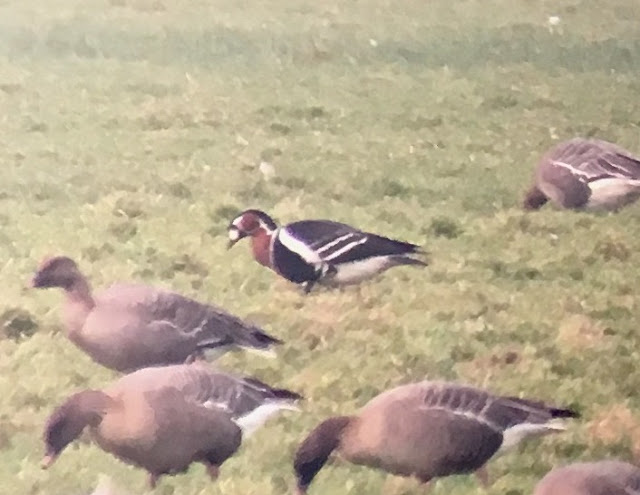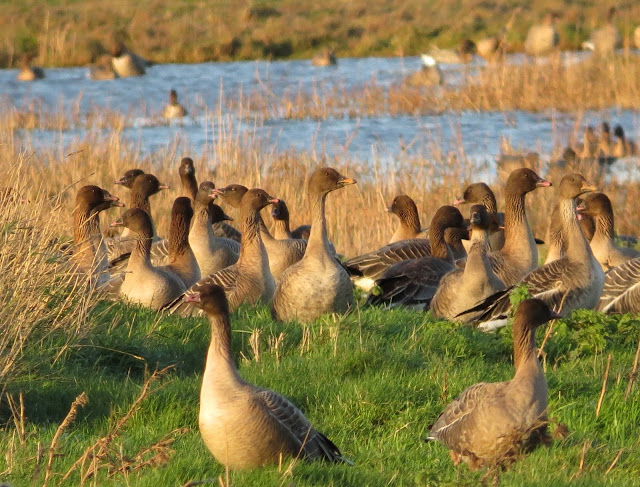Some birds seem to be much trickier to catch up with than
others and rather surprisingly, this winter’s Red-breasted Goose decided it was
going to be one of the awkward ones. Having already travelled down to Norfolk
at the end of December in an attempt to twitch it over the New Year period,
thick fog rather hampered our success, and despite Alex getting brief views
through the mist upon our arrival, the Red-breasted Goose rather disastrously
wasn’t seen again! A gruelling following two days endlessly searching the
surrounding fields and trawling through tens of thousands of geese in the
biting cold drew a blank (hours and hours of searching and staring at geese
resulted in me even seeing them in my sleep!), and with no further sightings of
the Red-breasted Goose at all in Norfolk, it seemed we’d mis-timed our visit
with it moving on to pastures new.
 |
| Goose! A total menace! |
Alex's Red-breasted Goose video!
Heading up ourselves on the Sunday morning, we rather
foolishly expected to rack up and enjoy great views of this colourful species
feeding in one of the regular fields. How wrong we were….. 6 hours later and
there was no trace of our goose, and with now freezing cold feet and a form of
goose depression setting in, we were left pondering just why this one goose
seemingly hated us…
 |
| The goose field - minus any Red-breasted ones! |
Joining the assembled birders and having not even got my
scope set up yet, it was a case of “right place, right time” as in what was one
of the most casual announcements of spotting a bird ever (second only to a
French birders deadpan “I have eet” proclamation of finding our much sought
after Dupont’s Lark in Spain) a lady exclaimed that she thought she had found
“the red one”.
 |
| The "Red One" |
Luckily Alex soon found it amongst the flock and getting my
own scope set up and on it we were finally able to enjoy prolonged views of
this beautiful, petite goose. With no fog to obscure our vision and remaining
out of the way of any bustling Pinkfeet, it was great to finally savour the sweet
taste of success – Red-breasted Goose in the bag.
So, the big question… is it gen?
With Red-breasted Geese breeding in far north Russia – in
the same area as Bean, White-fronted and Brent Geese, despite being amongst a
large Pink-footed Goose flock we can presume that this particular bird arrived
with the several White-fronted Geese that have been mixed in with the Pinkfeet.
 |
| Migrating Pinkfeet |
With several large Brent Goose flocks also overwintering down
in Norfolk, an alternative theory is that the Red-breasted Goose may have travelled
across to Britain with the Brent Geese before getting mixed in with the
Pink-footed Goose flocks, preferring the food source of the grassy fields as
opposed to the saltwater marshes favoured by Brent Geese. We did in fact actually
see several Brent Geese mixed in with the Pink-footed Goose flocks down in
Norfolk, showing that the two species do mingle.
 |
| The Norfolk Brent Geese |
Despite many Red-breasted Geese in Britain being of dubious
origin having escaped from captivity, this individual’s wild tendencies, migratory
patterns and association with carrier species (both Bean and White-fronted
Geese were present with it in Norfolk and at Cockerham) are enough to earn it
the benefit of the doubt for me.
Having given us the run-around for almost a month and
sending us on a wild goose chase half way across the country and back, it was a
weight off the shoulders to finally nail this (elusive for us!) individual!
Great work on Alex’s part driving to both Norfolk and Lancashire for me to
track down my goose – this almost makes up for him doing a runner to see a
White Stork without me in August… almost!
The Red-breasted Goose seems to favour a particular set of
fields adjacent to Cockerham Marsh, running alongside the A588 from Cockerham
to Stake Pool. The main flocks congregate between Braides and Sand Villa Farm
(postcode LA2 0EW) but we also found substantial flocks along Horse Park Lane
and Backsands Lane. Several birders have also been successful further north at
Upper Thurnham off the A588 layby just south of Moss Lane, while we found a
large flock at the end of Slack Lane on the other side of the Marsh. The most recent sighting came from Eagland Hill and Nateby, slightly further south.








The best duck hunting in Colorado is provided by Birds and Bucks Outdoors, which features expert guides, beautiful settings, and lots of exciting moments. Definitely unforgettable. duck hunting in Colorado
ReplyDeleteHighly recommend Birds and Bucks Outdoors for guided goose hunting in Colorado. Their expertise, preparation, and passion ensured a productive hunt with plenty of opportunities and unforgettable moments in the field.guided goose hunt Colorado
ReplyDelete